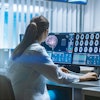President Clinton has signed a bill to establish the National Institute of Biomedical Imaging and Bioengineering at the U.S. National Institutes of Health, bringing a happy end to the lengthy saga of H.R. 1795. The bill was the last piece of unsigned legislation remaining on Clinton's desk, and he signed it into law without public comment.
Many U.S. radiologists have long favored the institute, believing that only a concerted national effort will command the resources necessary to realize the full potential of molecular medicine in the new century. Current U.S. imaging research wastes resources, institute advocates say, because the projects are uncoordinated, unfocused, and prone to communication lapses and duplication of effort.
Moreover, advocates believe that the disease-based research focus favored by the NIH can never substitute for the basic scientific knowledge an imaging institute would seek to acquire.
"In order to flourish and grow consistently at the NIH, a scientific field requires an organization with the mandate, the responsibility, the authority, and the resources to direct ... investigation in that field. In the NIH, only institutes possess those attributes," said Dr. Nick Bryan, radiology department chair of the University of Pennsylvania Health Systems, in testimony to Congress last September.
Dr. Reed Dunnick, radiology department chair at the University of Michigan hospitals, testified that the proposed institute "could do much to ensure that federal research dollars are expended more efficiently and productively."
Legislation to establish the institute at the NIH was first introduced in the House of Representatives in January 1999. Since then the intiative has attracted dozens of co-sponsors, both Republicans and Democrats, in both houses of Congress. However, the NIH has actively opposed it, stating that a separate institute would waste scarce resources without enhancing research.
As a rancorous Congress wrestled earlier this month with final health appropriations for 2001, opposition to the institute was strong enough to cause it to be separated from the larger spending bill (H.R. 5661). The House version of the initiative was then passed as stand-alone legislation December 15 and sent to the president. Had Clinton declined to sign it, he could have axed the institute without disturbing the broader 2001 health-spending package.
Fears were eased with today's signing, however, and the radiology community can now begin to plan for the institute's future.
By Eric Barnes
AuntMinnie.com staff writer
December 29, 2000
Imaging institute drive goes down to wire, December 19, 2000
House committee approves imaging institute; bill moves to final vote, September 15, 2000
Imaging institute hearing a success; legislation heads to full committee, September 14, 2000
House subcommittee to tackle proposed NIH imaging institute, September 11, 2000
More NIH funds could aid imaging effort, January 25, 2000
Radiology accelerates drive for imaging institute in 2000, January 11, 2000
Copyright © 2000 AuntMinnie.com

